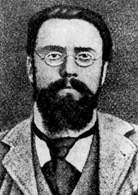
Born: July 15, 1871, Warsaw, Russian partition of Poland (presently Poland)
Died: February 21, 1958, Washington, District of Columbia,USA
Early days. Henryk Arctowski was born in Warsaw, Poland, on 15th July 1871.
Advanced studies. He started studies in Geology and Chemistry in Liege, Belgium, and then in France at the Sorbonne in Paris.
Co-organizing the Belgica Antarctic Expedition. In 1895, Arctowski contacted the famous Belgian explorer, Adrian de Gerlache de Gomery, organizer of the Belgica Antarctic Expedition, and started work as scientific vice-director. The Norwegian explorer, Roald Amundsen, and another Pole, Antoni Dobrowolski, also participated in this expedition, which lasted from 1897 to 1899 and became the first to winter in the Antarctic. Scientific work providing much valuable data in many disciplines was carried out as the trapped vessel drifted in the sea-ice.
In addition to observations of sea-ice formation and types of icebergs, Arctowski obtained a full year's cycle of meteorological observations. As oceanographer he prepared a bathymetric map from soundings he made during the ships drift.
Scientific success. His name has been given to a phenomenon in which a halo resembling a rainbow, with two other partial arcs symmetrical to the main one, forms around the sun as light is refracted through ice crystals in the atmosphere.
Publication.
On completing the expedition, Arctowski took employment at the "Observatoire Royal de Belgique" in Uccle where he worked on materials collected during the Belgica cruise and published the results in Résultats de voyage de “Belgica” (1903-1913).
Within the field of Geology he went on to conform his own so-called 'Antarktand' hypothesis involving the analogy between the formation of the South Andes, (particularly Tierra del Fuego) and the Graham Peninsula of the Antarctic continent. With respect to glaciology, he also found that the snow boundary had risen by 800 m since the last glacial maximum, according to his observations in the Beagle Channel. Apart from research work, he also delivered many lectures. During a stay in London he made the acquaintance of Arian Jane Addy, an American singer, whom he later married. In the summer of 1919, he participated in an expedition to Spitsbergen and the Lofoten Islands on the vessel, lle-de-France, as chief scientist.
Directing the natural sciences division at the NY Public Library. After his return, Arctowski organized the natural sciences division at the New York Public Library, where between 1911 and 1919 he held the post of division director. In 1919, he prepared the maps and a memorandum regarding Poland’s independence for the US delegation for the peace conference in Versailles.
Return to Poland.
In 1920, Arctowski returned to Poland where the then Prime Minister, Ignacy Paderewski, offered him the position of Education Minister. In order to continue his scientific work, however, he declined this offer and instead took the chair of Geophysics and Meteorology at the Jan Kazimierz University in Lwow, which in 1912 had conferred on him the degree of honoris causa Doctor. In 1935, he became a member of Polish Academy of Sciences and Letters (Polska Akademia Umiejetnosci). With his co-workers in Lwow, he published 133 papers in the institute’s journal.
Back in the USA. At the outbreak of war in 1939, Arctowski was in Washington, participating in the Congress of the International Geodetic-Geophysical Union as President of the International Commission of Climatic Changes. His return to Poland impossible, he accepted a position at the Smithsonian Institute. His first scientific success in this Institute was to demonstrate a positive correlation between 24 hour changes in the solar constant and sunspot area based on material collected between 1926 and 1930. In 1950, he gave up work in the Smithsonian because of ill health, but he continued research work. He died in Washington on 21st of February, 1958, having never returned to Poland.
Recognotion. In recognition of his work and his contribution to science, Arctowski’s name has been given to the Polish research station in the Southern Shetlands Archipelago and to a number of geographical features:
In Antarctica:
• Arctowski Peninsula
• Arctowski Nunataks
• Arctowski Peak
And in Spitsbergen::
• Arctowskifjellet (Mt. Arctowski)
• Arctowskibreen (Arctowski glacier).
Also, an Arctowski Medal was established in 1969 by the US National Academy of Sciences, awarded for studies in solar physics and solar-terrestrial relationships. In addition, a further sum is provided to an institution of the recipient's choice. Established through the Henryk Arctowski Fund by the bequest of Mrs. Jane Arctowski. A Polish stamp honoring him was issued in 1986.
Based on the biography published in
Patron
Other sources:
COMNAP
WIEM
Return to home page:
Prominent Poles